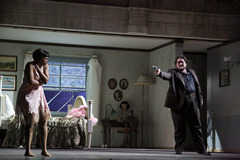| Opera Reviews | 4 May 2024 |
A Giordano rarity returns to La Scala after 90 yearsby Silvia Luraghi |
|
| Giordano: La cena delle beffe Teatro alla Scala, Milan 3 April 2016 |
|
|
Not that other companies have paid much more attention to this opera: in recent years, the most notable revival was staged in Bologna in 1999, in a co-production with the Opernhaus Zürich. There, general manager Alexander Pereira, a verismo lover, was so impressed by Giordano’s work that he decided to include the work at La Scala, where he has moved in the meantime. The libretto is based on a 1909 theater play by Sem Benelli, an Italian playwright and librettist, who also wrote the adaptation. The story is cruel and truculent: it is about the rivalry between two families, whose male members try to seduce (quite successfully) the same woman. At a dinner where they are supposed to settle their issues, Giannetto Malespini, who has previously been mocked by brothers Neri and Gabriello Chiaramantesi, manages to convince the others that Neri has turned mad. He then runs to Neri’s house and sleeps with his girlfriend Ginevra. When Neri returns, the only one to realize that he is not mad is Lisabetta, one of his former lovers. She tries to help him, but when Neri goes to his home at night and shoots the man he finds in his girlfriend’s bed thinking he is his enemy Giannetto, he instead turns out to be his brother. The discovery leaves Neri genuinely mad, and Giannetto embittered by his woeful victory. In the original libretto, the story is set in 16th century Florence, but as there are no links to the historical setting, the idea of finding a more compelling time setting encounters no obstacles. This is what director Mario Martone has done, with the valuable support of set designer Margherita Palli, whose work with the company is currently being celebrated by an exhibit at La Scala’s workshop area Ansaldo. Martone staged the opera among mafia families in Little Italy in the 1920s-1930s. A three-storey building shows a restaurant where the men meet in the first act for the dinner. The upper floor is Neri’s home with Ginevra’s bedroom, while the basement offers a stage for Neri’s conviction in the third act. In the end, all the mafiosi gather again in the restaurant, only to be shot by their women who suddenly come inside from the front door. Giordano’s score calls for accomplished singers, technically prepared, who can produce a huge volume of sound without shouting. This was fortunately the case in this production, where especially tenor Marco Berti as Giannetto and baritone Nicola Alaimo as Neri proved to be ideally cast. Soprano Kristin Lewis as Ginevra sounded somewhat at odds with her control of top notes, but she also gave a very good contribution, as did soprano Jessica Nuccio as Lisabetta. Both the four of them as well as all other principals turned out to be great singer-actors, a quality which is essential in verismo operas. The orchestra was insightfully conducted by Carlo Rizzi. Opening night was very successful for all artists involved in the production, with the production team for once receiving even more applause than the singers.
|
|
| Text ©
Silvia Luraghi Photo © Teatro alla Scala |

 Composer Umberto Giordano is universally celebrated for Andrea Chenier and Fedora; however he composed many more operas, which can still turn out to be a real discovery when compellingly staged and sung. This was the case with La cena delle beffe, or The Jesters' Supper, one of Giordano’s later operas, which premiered at La Scala in 1924 and is now back, 90 years after the last revival in 1926.
Composer Umberto Giordano is universally celebrated for Andrea Chenier and Fedora; however he composed many more operas, which can still turn out to be a real discovery when compellingly staged and sung. This was the case with La cena delle beffe, or The Jesters' Supper, one of Giordano’s later operas, which premiered at La Scala in 1924 and is now back, 90 years after the last revival in 1926. 





